Today, if you want to build AI software, you have a list of programming languages to choose from. Currently, Python is the undisputed winner, at least in the popularity contest. However, depending on your project's needs, the best programming language might be something else.
To help you navigate this critical choice, I’ve curated a list of the seven programming languages that are currently leading the way in AI development. Additionally, I’ve included code snippets written in the respective language that perform the same task to give you a clearer picture of the language’s differences. Each snippet connects to OpenAI, prompts the model, and returns a response.
Whether you’re focused on deep learning, data analysis, or natural language processing, I hope to help you select the language that aligns best with your project goals. Let's get started!
Best Programming Language for AI
- Python
- Javascript
- Typescript
- Rust
- Go
- Java
- C++
1. Python: The Swiss Army Knife of AI
Python is the go-to language for most people who want to get into AI development. And it’s easy to see why.
For a start, Python is a simple and easy-to-learn programming language. Imagine skipping hours of classes on complex programming syntax and starting to code right away. Moreover, you don’t need to write dozens of lines of code just to do something simple, like reading a text file.
Also, Python is an interpreted language, which means that the code you write can be executed directly on all platforms without the need for a compiler.
Why I Like Python
- Rich libraries: You can use libraries like TensorFlow, PyTorch, and Scikit-learn to build deep learning models for image processing, NLP, and more.
- Community support: Python boasts a thriving community of developers who contribute to its ecosystem, offering a wealth of tutorials, forums, and open-source projects.
- Versatility: Beyond AI, Python is widely used in web development, data analysis, and scientific computing, making it easier to integrate AI capabilities into different aspects of a project.
How to Use Python for AI
- Generative AI: Connect with large language models (LLMs) with frameworks like LangChain, which support Python.
- Deep learning: Frameworks like TensorFlow and PyTorch make Python a go-to language for creating complex neural network architectures.
- Natural language processing: Libraries such as NLTK and spaCy offer comprehensive tools for text analytics and language processing tasks.
- Data analysis: With packages like Pandas and NumPy, Python excels in data manipulation and statistical analysis, which are essential in training and understanding AI models.
Where I’ll Exercise Caution
- Performance: The trade-off with Python’s simplicity is slower code execution speed. Basically, I wouldn’t use Python if I wanted to build a millisecond-latency application.
- Mobile-native capabilities: Python lacks libraries and frameworks for creating responsive mobile apps.
- Memory management: There are risks of memory leaks when coding in Python. This can result in abnormally high memory usage or app crashes.
Python Code Snippet
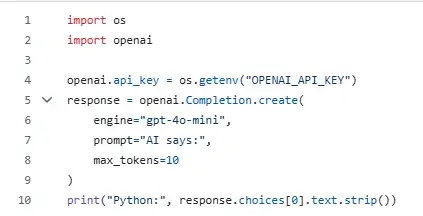
My Verdict
Python offers a balanced mix of ease-of-use, versatility, and a rich set of libraries, making it a strong contender for any AI project. Whether you are a novice looking to dip your toes into the AI pool or a seasoned developer aiming for a deep dive, Python provides the tools to make your journey both possible and effective.
2. JavaScript: AI for the Web
JavaScript is a browser-native scripting language that enables web developers to create more interactive websites. For example, if I want to animate the tagline on my homepage with typewriter effects, I use JavaScript.
When you write code for JavaScript, you associate it with an event, which serves as a trigger. The language is also helpful for building backend services that power a website. So, it isn’t surprising that JavaScript is getting attention for AI development.
Why I Like JavaScript
- Browser compatibility: JavaScript can run in any browser, making it incredibly accessible for web-based AI implementations. You can train and run machine learning (ML) models on the browser with libraries like TensorFlow.js and ONNX.js.
- Asynchronous operations: JavaScript's non-blocking I/O model is perfect for real-time applications like chatbots or interactive user interfaces. This means your app can query an LLM and continue doing other things without getting stuck.
- Full-stack development: Whether you want to build a client-side ML web app or integrate AI functionalities on the backend, you can use JavaScript.
How to Use JavaScript for AI
- Chatbots: JavaScript frameworks like Node.js offer real-time capabilities and event-driven programming, making them ideal for building chatbots that respond quickly to queries.
- Personalized user experience: Machine learning models trained to run in the browser can provide real-time, personalized recommendations and adapt based on interactions.
- Web-based games: For games that utilize AI to control game logic or characters, JavaScript's quick execution and browser compatibility make it an excellent choice.
Where I’ll Exercise Caution
- Complex AI workload: JavaScript was not designed for heavy computational tasks, including AI workloads.
- Limited choices of AI libraries: Although you have access to libraries like Tensorflow.js , JavaScript still falls behind the likes of Python in terms of AI frameworks.
- Single-threaded language: JavaScript runs a piece of code at any one time, which limits its ability to perform parallel processing. Although you can expand its thread processing with tools like Worker Threads, there are still restrictions to keep in mind.
JavaScript Code Snippet
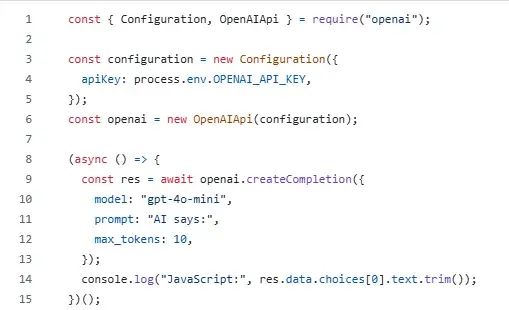
My Verdict
JavaScript brings AI development closer to browser-based applications. While it may not yet have the extensive AI-focused libraries that languages like Python do, many developers are already building with JavaScript, which welcomes AI integration into the language.
If your AI project is geared towards the web or you're aiming for seamless user interaction, I think JavaScript should be on your radar.
3. TypeScript: Safer AI Apps
Many would argue that TypeScript is not a programming language, considering how it is a superset of JavaScript. However, I feel it deserves a spot on this list as it introduces programming guardrails that many ML devs find useful.
For context, JavaScript uses dynamic typing while TypeScript supports typing. Unlike JavaScript, you must specify the type of variable before you use it in TypeScript. Personally, I prefer statically typed languages like TypeScript because I won’t confuse variables, especially those that share common names in different functions.
Moreover, any related errors are caught early on. Because of this, TypeScript saves web developers from unnecessary mistakes when they take on complex AI projects.
Why I Like TypeScript
- Type safety: You can catch many errors when compiling the code instead of during runtime. This reduces the chances of bugs slipping into the production environment.
- Growing AI libraries: Not only can you use JavaScript AI libraries like TensorFlow, but you can also work with TypeScript-specific libraries like TypeAI and Axilla.io.
- Coding experience: Coding in TypeScript is also more effortless with better tools like autocomplete and in-line documentation.
How to Use TypeScript for AI
- Backend AI integration: You can build a server-side application that safely communicates with large language models with an application programming interface (API).
- Interactive dashboard: As TypeScript works natively in browsers, you can use it to build real-time analytics dashboards.
- Browser extensions: Again, TypeScript’s browser support makes it easy to build AI-powered browser plug-ins, such as an AI summarizer or sentiment analyzer.
- Cloud-based AI apps: Being a lightweight language, TypeScript can help you create scalable cloud AI apps.
Where I’ll Exercise Caution
- Learning curve: Even if you’re familiar with JavaScript, you’ll still need to learn type annotations and other syntax in TypeScript.
- Compilation: Before you can run TypeScript code, you’ll need to compile it, which introduces an additional step. And if you’re compiling a large project, you’ll need to exercise patience, as it might take minutes.
- Proficiency: The language has only recently garnered attention. So, it might take a while before more developers adopt the language.
TypeScript Code Snippet

My Verdict
My opinion is that TypeScript is a safer JavaScript alternative for building complex artificial intelligence and machine learning projects. The fact that it helps web developers reduce type errors, or at least spot them early on, makes it worth exploring.
4. Rust: High-Speed AI Without the Crashes
Rust is gaining popularity amongst the AI development fraternity as a language that complements Python. Unlike Python, Rust compiles code to machine language, allowing your AI program to run faster. Moreover, Rust has a better memory management model, which means fewer risks of memory leaks and crashes compared to Python or C++.
Another reason that got me excited about Rust is the multi-threading capability. Languages like Python and JavaScript are primarily single-threaded. This means I can’t execute functions in parallel, but I can now do it with Rust. And that’s a huge advantage if you want to build complex AI apps that respond in real time.
Why I Like Rust
- Performance: Rust runs programs in machine language, which eliminates performance bottlenecks that affect interpreted languages like Python.
- Growing ecosystem: More developers are adopting Rust, which lets you build with AI libraries like ndarray, tch-rs, and burn.
- Integrate with python: Rust does not seek to replace Python. Instead, it integrates with the Python ecosystem. Basically, I can retain my Python projects and migrate computationally intensive data analytics to Rust.
How to Use Rust for AI
- Edge computing: Rust’s superior performance makes it an ideal language for bringing AI computing closer to data sources. For example, you can use Rust for programming IoT devices or sensor monitoring systems.
- Autonomous systems: AI systems that demand low-latency responses, such as autonomous vehicles and robotic arms, can benefit from Rust’s parallel processing.
- AI inference engine: Rust is an ideal candidate for building the intelligent core of an AI system, which requires fast and accurate reasoning capabilities.
Where I’ll Exercise Caution
- Compilation: Be prepared to sit through a longer compilation time if you’re building complex AI software with Rust.
- Learning curve: Rust introduces concepts that developers may take some time to grasp. For example, Rust doesn’t use garbage collection for memory management. However, you’ll need to understand ownership, borrowing, and slices to safely manage memory.
- Backward compatibility: Rust is still evolving, and it lacks support for older code. This means if you update Rust, you might need to rewrite parts of your code.
Rust Code Snippet
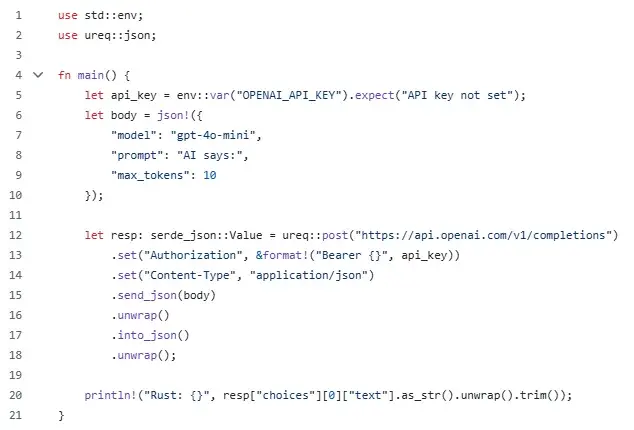
My Verdict
Rust brings in powerful AI performance with fewer risks of memory leaks compared to popular interpreted languages. Use it for mission-critical AI applications where speed is non-negotiable. The great thing is that you can integrate Rust with Python, leveraging the best of both languages.
5. Go: Scaling AI Without Overhead
Go, or Golang, is a relatively new programming language introduced in 2009 that gained wider adoption in 2012. And guess who picked it up early on? Python developers.
As I’ve mentioned, Python is popular for data science and AI projects. However, it’s challenging to scale Python code in production, mainly because of performance bottlenecks, dynamic typing, and memory management challenges.
Go, on the other hand, uses static types to remove the ambiguous use of variables, which often leads to production issues. While Python lets you build with AI models easily, Go lets you connect applications to the models at scale. And the best thing? Go, to a certain extent, retains Python’s language simplicity.
Why I Like Go
- Scalable: Go’s static type checking and memory management make it ideal for building large, scalable apps. Plus, code built in Golang also consumes much less memory.
- Performance: Go is a powerful machine-compiled language. Expect a multifold performance boost when you process large volumes of data compared to Python.
- Concurrency support: You can run multiple codes in Go simultaneously with special functions called Goroutines. They’re like threads in programming languages like Java and Rust.
How to Use Go for AI
- Data transformation tools: With Go’s concurrency processing, you can build an effective channel for collecting and transforming data that the AI model uses.
- AI-powered microservices: Go is a lightweight programming language that lets you create programs that consume minimal resources. This makes Go ideal for building distributable microservices.
- Predictive analytics: Go is well known for its efficiency, especially when handling large volumes of data. You can use Go to build recommendation systems that process data from multiple sources and return near-real-time results.
Where I’ll Exercise Caution
- Limited AI libraries: While you use libraries like Gorgonia, Golearn, and ONNX for machine learning functions, Go has yet to rival Python in terms of AI libraries and frameworks.
- Error handling: Catching errors in Golang can be challenging due to the language's verbosity. As your code grows in complexity, you may need to write repetitive lines of code to check and handle errors.
- Learning curve: Compared to Python, it might take more time to become familiar with Golang. After all, it’s still a young language and lacks resources to learn from.
Golang Code Snippet
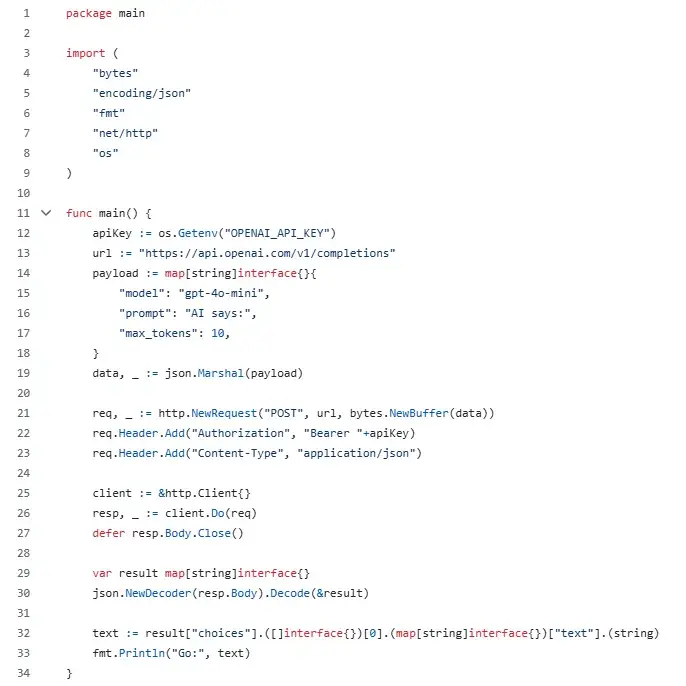
My Verdict
Go balances stability, performance, and simplicity to help AI developers scale the software they build. I recommend you use Go when you need to build reliable data pipelines, microservices, or AI systems with high performance.
6. Java: Bridging Scalability and Versatility
Java has been around for decades. I remember building a point-of-sale application with Java as the language became widely adopted for web applications. Today, Java is one of the most popular programming languages, including for AI projects.
While you can use Java for building almost any type of software, it’s often used for building enterprise applications. These applications need a programming language that can scale without compromising speed and stability. Java’s multi-threading support, along with a robust memory management system, puts it in a strong position for building compute-intensive AI applications.
Why I Like Java
- Platform independence: Java's “write once, run anywhere” philosophy is invaluable for AI applications that need to be deployed across multiple platforms without modifications.
- Strongly typed: Java's type-checking system at both compile and runtime can catch errors early, thus providing a safety net during the development process.
- Multi-threading support: The language’s robust multi-threading capabilities enable efficient execution and better CPU and resource usage, which is crucial for intensive AI computations.
How to Use Java for AI
- Search algorithms: The in-built support for data structures and algorithms in Java makes it suitable for building AI applications that rely heavily on search algorithms for decision-making.
- Neural networks: While not as extensive as Python's offerings, Java still has a range of libraries like Weka, Deeplearning4j, and JavaML. They let you easily transform data and run machine learning algorithms within the application.
- Big data analysis: Java's scalability features and compatibility with Hadoop make it a strong contender for AI projects that require big data processing.
Where I’ll Exercise Caution
- Performance: The trade-off for Java’s platform independence is the slower code execution due to an additional layer of runtime environment. Although Java works well for most applications, I don’t suggest using it for mission-critical AI applications that require high throughput.
- Code complexity: Java is a verbose language, which means it takes more lines of code to execute a function. Learning the syntax can be challenging. Personally, I wouldn’t recommend Java for beginners who want to experiment with AI.
- Memory usage: Java’s garbage collection mechanism prevents memory leaks in the app. However, the way it’s implemented can lead to excessive memory usage.
Java Code Snippet

My Verdict
In a nutshell, Java’s platform-agnostic nature, type safety, and scalability make it a reliable choice for AI projects with complex requirements. If you’re planning an AI project that will need to scale and adapt over time, Java's robustness and flexibility offer a solid foundation upon which to build.
7. C++: Where Performance Meets AI
If performance is a top priority for your AI project, you can't go wrong with C++. Known for its high-speed execution, C++ is commonly used in applications where low latency and real-time performance are crucial.
Coding in C++ requires strict adherence to syntax and rules like explicit variable declaration, pointers, and structures. Unlike Python, code written in C++ can be difficult to read and understand. Still, being an object-oriented language, C++ has influenced many modern languages, including Java.
Why I Like C++
- Speed and efficiency: C++ is well-known for its efficiency in terms of both memory and speed, which is critical for AI tasks requiring instantaneous decision-making, such as autonomous vehicles or high-frequency trading.
- Low-level manipulation: The language provides the ability to perform low-level memory manipulations, offering greater control over computer resources.
- Memory management: Unlike languages that rely heavily on garbage collection, C++ allows for explicit memory management, enabling optimized performance.
How to Use C++ for AI
- Robotics: When it comes to robotic applications that require real-time decision-making, C++ stands out for its low latency and high-speed execution.
- Real-time systems: Whether it's financial trading systems or embedded technology in medical devices, C++ is often the language of choice due to its performance capabilities.
- Game development: In gaming, AI often has to make real-time decisions to control non-player characters, making C++ a natural fit for such scenarios.
Where I’ll Exercise Caution
- Difficult to learn: C++ is not the easiest language to pick up. It might take months before a beginner can understand memory allocations, pointers, functions, and other concepts in the language.
- Memory leaks: While you have more control over memory allocation, you’re solely responsible for reclaiming used memory. Otherwise, the app you build might suffer from memory leaks, instability, and crashes.
- Maintenance: When working in a team, I recommend you make sure all codes are properly documented. Being a verbose and complex language, C++ is difficult to maintain, especially over time.
C++ Code Snippet
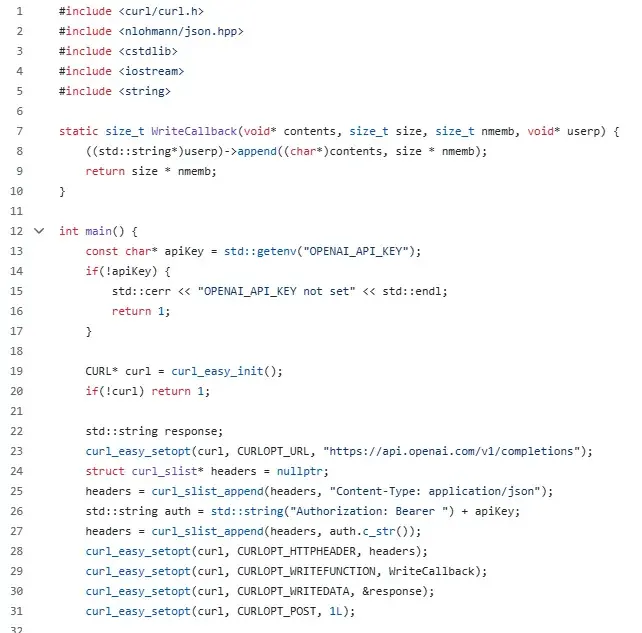
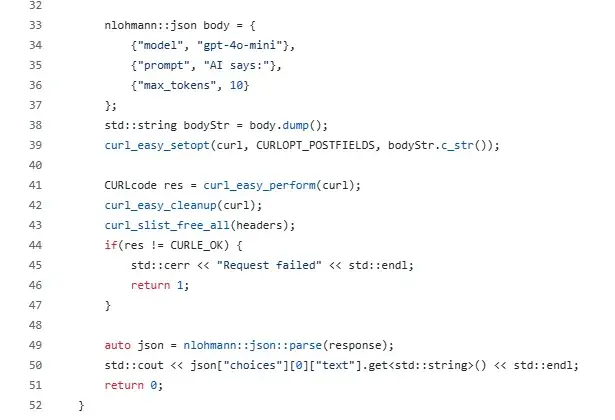
My Verdict
C++ is a highly efficient, performance-oriented language that is an excellent choice for AI applications requiring rapid computation and low latency. While it may come with a steeper learning curve compared to languages like Python, the performance advantages it offers often outweigh the initial investment in learning the language.
If you’re looking to push the boundaries of what’s possible in real-time, high-performance AI applications, I believe C++ is a language you should seriously consider.
Choose your AI programming language wisely.
Deciding on the right programming language for your AI project can be daunting, but the choice you make can significantly impact the project‘s success. Whether it’s Python’s versatility or C++’s performance, each language offers unique advantages and trade-offs tailored to different AI needs and applications.
The landscape of AI is ever-evolving, and the tools we use today may be replaced or augmented as new languages and frameworks enter the scene.
If you’re just getting started in the AI world, I think it’s worthwhile to become proficient in one of the more established languages like Python or Java. However, don’t hesitate to venture out and explore the capabilities of newer entrants like Go or TypeScript, especially if they align closely with your specific project requirements.
With this guide in your arsenal, you're well-equipped to make an informed decision about what programming language is best fo your AI endeavors.
Editor's note: This post was originally published in September 2023 and has been updated for comprehensiveness.
Artificial Intelligence












